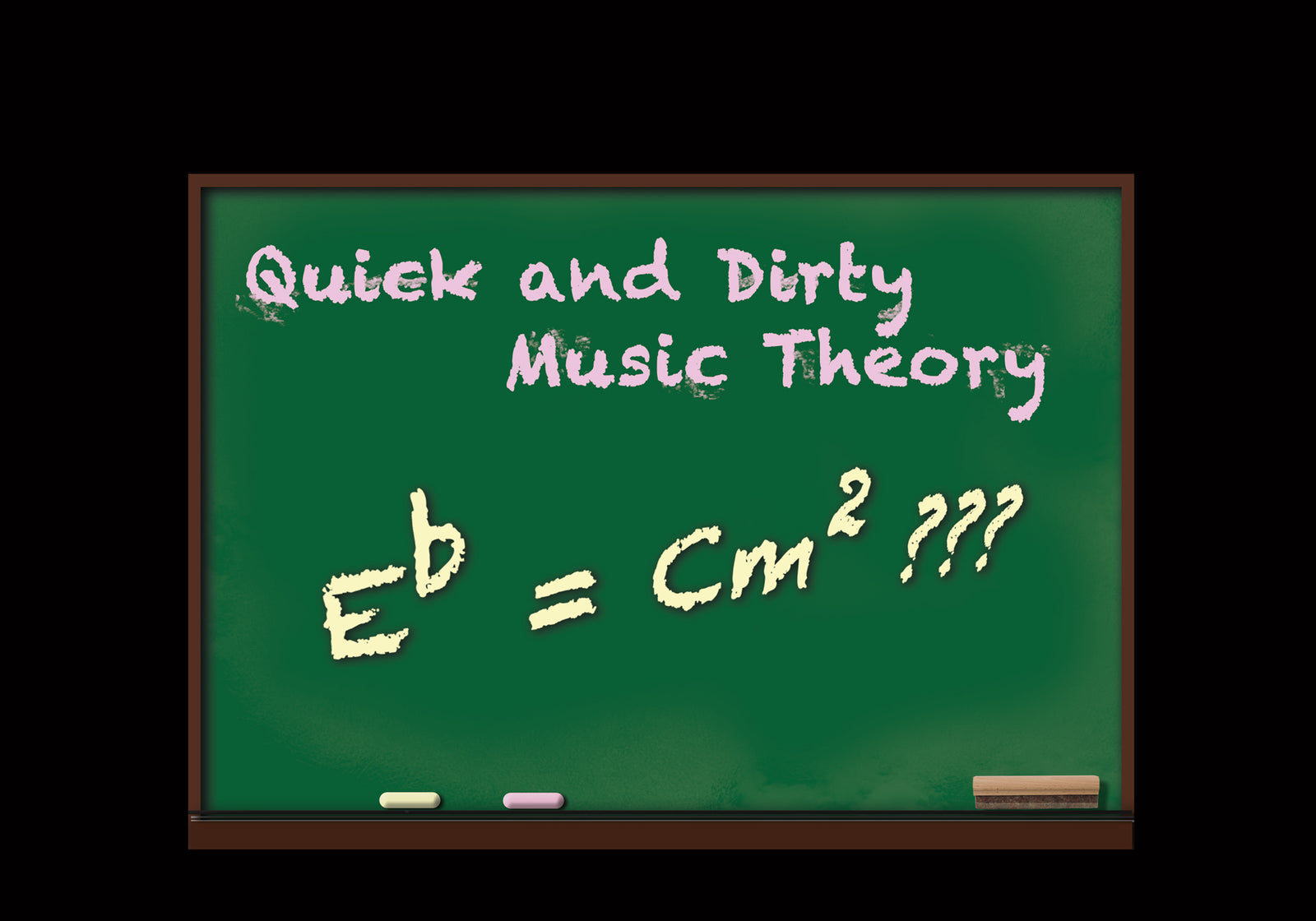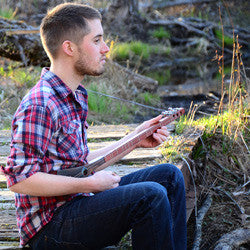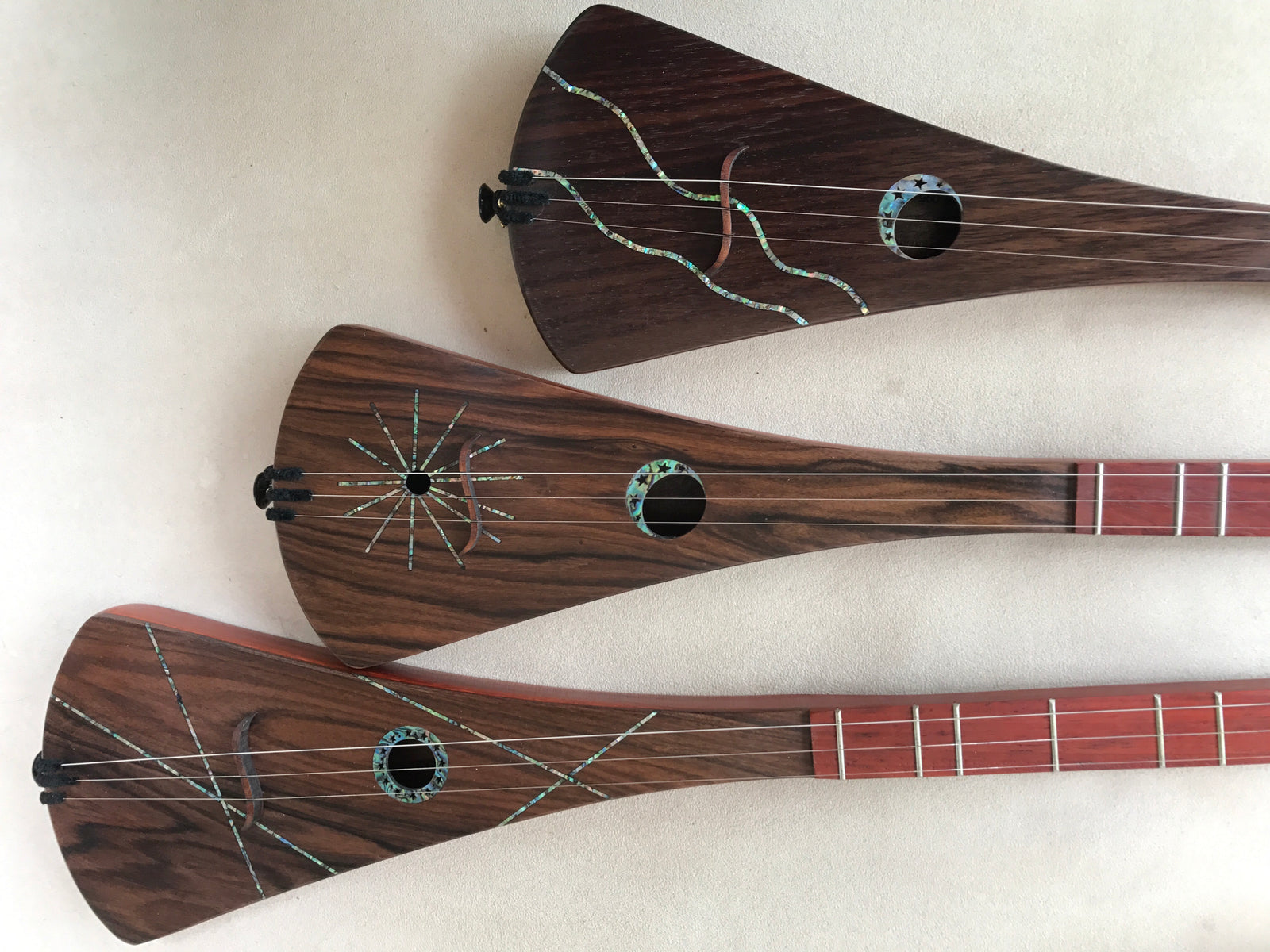Quick and Dirty Music Theory:
Music theory is based on a system. It is an awkward system with a couple of Mysteries built in, but it is a simple enough system, once you understand the Mysteries!
A. Scales and how notes are named:
1. The Chromatic Scale (all the notes): [interval is always a halftone, a halftone interval being 1/12th of an octave].
A A# B C C# D D# E F F# G G# A
The symbol # (sharp) means “a halftone higher than”. so the name of the note after A is A# (A Sharp), “The Note A Halftone Higher than A”. A clumsy naming system, but it’s what we have.
Here is the chromatic scale written twice, to cover two octaves, we’ll need it in a while.
A A# B C C# D D# E F F# G G# A A# B C C# D D# E F F# G G# A
Flat Notes: (Mystery Number One!)
♭(flat) means “a halftone lower than”. We will Write the symbol with the lowercase b. So the note a halftone lower than B is B♭. We will write that as Bb to simplify typing.
Mystery Number 1: A# means the same thing same as B flat;
The note “a halftone higher than A” is the same exact note as as the note “a halftone lower than B”
C# means the same note as Db, D# means same as Eb, F# is the same as Gb, and G# is the same as Ab.
As we write the Chromatic scale, I am using all “#” names for the “in-between" notes, but I could have used the appropriate “b” name.
Mystery Number 2: Where is B#-Cb and E#-Fb???
The alert will have noticed B-C and E-F have nothing in between them??Surprise, there is no # between B and C, or E and F because those notes are already an exact half tone apart…I told you it was an awkward system.
So here is the chromatic scale, using just the # named notes, written over two octaves
A A# B C C# D D# E F F# G G# A A# B C C# D D# E F F# G G# A
What’s an Octave?? Mystery Number 3:
“Notes an octave apart are the same note, but one is higher and one is lower.”
What kind of mumbo-jumbo is this?? Just take it as given truth for now, this is how it is, the explanations of why are even worse. Trust us on this. Suffice to say, as you play the chromatic scale A ,A# ,B etc, you eventually arrive at G# (the note a halftone higher than G) and the next note is….H!
NO no no…it is A, again, and the pattern repeats but one octave higher. Notes an octave apart are interchangeble. Don’t ask.
Mystery Number 4: Why it an Octave not a “Twelve-tave”.
The Octave was discovered at a time scales only used 8 notes, which cover the interval of an octave (Octo is Latin for 8). When it got fancy and the “in-between notes were needed, we wound up with the 12 halftone per octave system. Aren’t you glad you asked?
2. The Major Scale, back to 8 notes…
To make a Major Scale, any key:
start from a given note ( called the ROOT note, which gives it's name to the key) and count half-tones, collecting notes as you go, 2,2,1 ,2,2,2,1
(you could also say whole whole half, whole, whole, whole half).
Starting from from G, looking at the Chromatic scale, that gives us
G A B C D E F# G (Note the B-C halftone interval, and the F#-G halftone)
Starting from From D it would give D,E F# G A B C# D.
(Check my counting!).
This sequence is the famous do-re-mi-fa-sol-la-ti-do sequence you may have learned in grade school, and possibly the only thing you can say in Italian other than "espresso". It is also a vital entry point into how music theory works, how songs are made, how chords are constructed, and what “Keys” are about. If you are in Key of G (technically “key of G major,” but “major” is assumed unless you say “minor” so “major” is rarely written, or said)…If you are in key of G, and sang Twinkle Twinkle, you would sing
“ G G DD EE D, C C B B A A G”. In grade school that would have been:
“do do sol sol la la sol, fa fa mi mi re re do”, and you might have wondered why you didn’t just sing:
Twin-kle twin-kle lit-tle star, how I won-der what you are.
B.Chords (Groups of notes at same time)
A chord is a group of notes that sound good together (usually). Chords come in various Types (or flavors) ,each Type with a distinctive sound.
The first Type is a “Major Chord”.
To build a GMajor chord, write the scale for Key of G (G is the Root note in this case) G A B C D E F# G then select:
the 1st note, the 3rd note, and the 5th note (also called 1,3,5). Using key of G, that is G, B, D, the notes that make a GMajor chord.
To build a DMajor chord, use a D Major scale D E F# G A B C# D.
1, 3 and 5 are D, F#, A
What would a Cmajor chord be? how about an A major chord?
To make a minor chord:
1, 3b, 5 (note the 3 is lowered by a halftone, thats why it is 3b)
That makes Gminor (written Gm) G, Bb (or A#),
From key of D, D E F# G A B C# D
a Dminor chord (Dm) is 1,3b,5 , D F A
Seventh chord (you can skip them and just use major in many situations)
1,3,5,7b... technically it should be called a “flat seventh” chord but it is usually called “seventh” G7 is G,B,D,F
Do I have to write a major scale out for every key to build chords??
No. A faster way, without writing major scales is to just work from chromatic scale:
Major chord: Root, up 4 halftones, up 3 halftones ( try it with G)
Minor Chord: Root, up 3 halftones, up 4 halftones
Seventh chord Root, up 4, up 3, up 3 again
G 1 2 3 B 1 2 D GBD, Gmajor Chord
A A# B C C# D D# E F F# G G# A A# B C C# D D# E F F# G G# A
E 1 2 G 1 2 3 B EGB Eminor chord
A A# B C# D D# E F F# G G# A A# B C C# D D# E F F# G G# A
A 1 2 3 C# 1 2 E 1 2 G AC#EG A7 chord
A A# B C C# D D# E F F# G G# A A# B C C# D D# E F F# G G# A
Each type of chord has its own “formula”.






Brian Gerhard
October 09, 2022
Tony,
I would love to study the work you have done in an effort to play and develop a better understanding of cord progression.
Thank you,
Brian